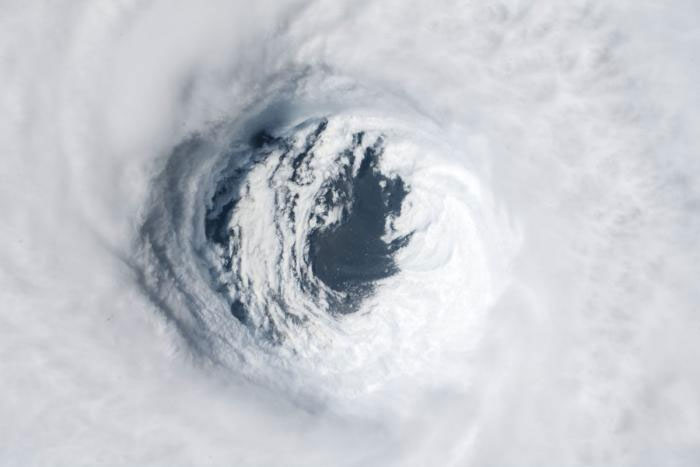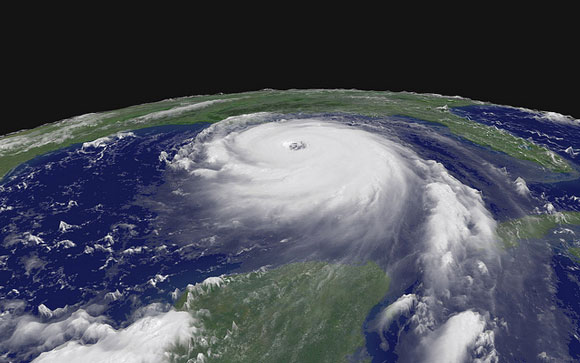
The 2021 Atlantic hurricane season is on. The season officially starts June 1 and extends through November 30.
Just a few days after the National Oceanic and Atmospheric Administration (NOAA) released this year’s hurricane season outlook, predicting a busier-than-average hurricane season, Tropical Storm Ana became the first named storm of the season when it formed off Bermuda on May 22. That makes 2021 the seventh straight year in which at least one named storm has developed in the Atlantic basin before hurricane season’s official start date.
Where do hurricane names come from?
Did you ever wonder how hurricanes get their names, and why they have names at all? Meteorologists long ago learned that naming tropical storms and hurricanes helps people remember the storms, communicate about them more effectively, and consequently stay safer if and when a particular storm strikes a coast.
These experts assign names to hurricanes according to a formal list of names that is approved before the start of each hurricane season. The U.S. National Hurricane Center started this practice in the early 1950s. Now, the World Meteorological Organization (WMO) generates and maintains the list of hurricane names.
Here are the hurricane names for 2021
Atlantic hurricane names (season runs from June 1 to November 30) are: Ana, Bill, Claudette, Danny, Elsa, Fred, Grace, Henri, Ida, Julian, Kate, Larry, Mindy, Nicholas, Odette, Peter, Rose, Sam, Teresa, Victor and Wanda.
Although NOAA forecasts a busy 2021 Atlantic hurricane season, the agency doesn’t anticipate the historic level of storm activity seen in 2020’s record-breaking season, which had 30 named storms. It was only the second time the list of storm names was exhausted in a season since naming began. But, in case all 21 names are used again this year, here’s a new supplemental list from the WMO: Adria, Braylen, Caridad, Deshawn, Emery, Foster, Gemma, Heath, Isla, Jacobus, Kenzie, Lucio, Makayla, Nolan, Orlanda, Pax, Ronin, Sophie, Tayshaun, Viviana, and Will.
Eastern North Pacific hurricane names (season runs from May 15 to November 30) are: Andres, Blanca, Carlos, Dolores, Enrique, Felicia, Guillermo, Hilda, Ignacio, Jimena, Kevin, Linda, Marty, Nora, Olaf, Pamela, Rick, Sandra, Terry, Vivian, Waldo, Xina, York, and Zelda.
If you’re interested, you can view those names, and names for upcoming years, at the U.S. National Hurricane Center.

How and why did hurricanes first begin receiving names?
While people have been naming major storms for hundreds of years, most hurricanes were originally designated by a system of latitude-longitude numbers, which was useful to meteorologists trying to track these storms. Unfortunately, this system confused people living on coasts seeking hurricane information.
In the early 1950s, the U.S. National Hurricane Center first developed a formal practice for storm naming for the Atlantic Ocean. At that time, storms were named according to a phonetic alphabet (e.g., Able, Baker, Charlie) and the names used were the same for each hurricane season; in other words, the first hurricane of a season was always named “Able,” the second “Baker,” and so on.
In 1953, to avoid the repetitive use of names, the National Weather Service revised the system so that storms would be given female names. By doing this, the National Weather Service was mimicking the habit of naval meteorologists, who named the storms after women, much as ships at sea were traditionally named for women.
In 1978–1979, the system was revised again to include both female and male hurricane names.
See the complete history of naming hurricanes, from NOAA
When does a storm receive a name?
Tropical storms are given names when they display a rotating circulation pattern and wind speeds reach 39 miles per hour (63 kilometers per hour). A tropical storm develops into a hurricane when wind speeds go above 74 mph (119 kph).
Experts have developed lists of hurricane names for many of the major ocean basins around the world. Today, there are six lists of hurricane names in use for Atlantic Ocean and Eastern North Pacific storms. These lists rotate, one each year. That means the list of this year’s hurricane names for each basin will come up again six years from now.
There’s an exception to this practice, however. The WMO retires the names of extremely damaging hurricanes for legal, cultural sensitivity, and historical reasons. For example, the use of the name Katrina was retired in 2005 following the devastating impact that Hurricane Katrina had on New Orleans. In March 2019, the WMO removed the names Florence and Michael from its lists for the Atlantic Ocean basin and replaced the names with Francine and Milton. Hurricanes Florence and Michael, which respectively struck the coasts of North Carolina and Florida in 2018, each caused tremendous damage and dozens of fatalities.

Bottom line: How hurricanes get their names, and the hurricane names for the 2021 season.
The post What are the 2021 hurricane names? first appeared on EarthSky.
from EarthSky https://ift.tt/3fFjY1i

The 2021 Atlantic hurricane season is on. The season officially starts June 1 and extends through November 30.
Just a few days after the National Oceanic and Atmospheric Administration (NOAA) released this year’s hurricane season outlook, predicting a busier-than-average hurricane season, Tropical Storm Ana became the first named storm of the season when it formed off Bermuda on May 22. That makes 2021 the seventh straight year in which at least one named storm has developed in the Atlantic basin before hurricane season’s official start date.
Where do hurricane names come from?
Did you ever wonder how hurricanes get their names, and why they have names at all? Meteorologists long ago learned that naming tropical storms and hurricanes helps people remember the storms, communicate about them more effectively, and consequently stay safer if and when a particular storm strikes a coast.
These experts assign names to hurricanes according to a formal list of names that is approved before the start of each hurricane season. The U.S. National Hurricane Center started this practice in the early 1950s. Now, the World Meteorological Organization (WMO) generates and maintains the list of hurricane names.
Here are the hurricane names for 2021
Atlantic hurricane names (season runs from June 1 to November 30) are: Ana, Bill, Claudette, Danny, Elsa, Fred, Grace, Henri, Ida, Julian, Kate, Larry, Mindy, Nicholas, Odette, Peter, Rose, Sam, Teresa, Victor and Wanda.
Although NOAA forecasts a busy 2021 Atlantic hurricane season, the agency doesn’t anticipate the historic level of storm activity seen in 2020’s record-breaking season, which had 30 named storms. It was only the second time the list of storm names was exhausted in a season since naming began. But, in case all 21 names are used again this year, here’s a new supplemental list from the WMO: Adria, Braylen, Caridad, Deshawn, Emery, Foster, Gemma, Heath, Isla, Jacobus, Kenzie, Lucio, Makayla, Nolan, Orlanda, Pax, Ronin, Sophie, Tayshaun, Viviana, and Will.
Eastern North Pacific hurricane names (season runs from May 15 to November 30) are: Andres, Blanca, Carlos, Dolores, Enrique, Felicia, Guillermo, Hilda, Ignacio, Jimena, Kevin, Linda, Marty, Nora, Olaf, Pamela, Rick, Sandra, Terry, Vivian, Waldo, Xina, York, and Zelda.
If you’re interested, you can view those names, and names for upcoming years, at the U.S. National Hurricane Center.

How and why did hurricanes first begin receiving names?
While people have been naming major storms for hundreds of years, most hurricanes were originally designated by a system of latitude-longitude numbers, which was useful to meteorologists trying to track these storms. Unfortunately, this system confused people living on coasts seeking hurricane information.
In the early 1950s, the U.S. National Hurricane Center first developed a formal practice for storm naming for the Atlantic Ocean. At that time, storms were named according to a phonetic alphabet (e.g., Able, Baker, Charlie) and the names used were the same for each hurricane season; in other words, the first hurricane of a season was always named “Able,” the second “Baker,” and so on.
In 1953, to avoid the repetitive use of names, the National Weather Service revised the system so that storms would be given female names. By doing this, the National Weather Service was mimicking the habit of naval meteorologists, who named the storms after women, much as ships at sea were traditionally named for women.
In 1978–1979, the system was revised again to include both female and male hurricane names.
See the complete history of naming hurricanes, from NOAA
When does a storm receive a name?
Tropical storms are given names when they display a rotating circulation pattern and wind speeds reach 39 miles per hour (63 kilometers per hour). A tropical storm develops into a hurricane when wind speeds go above 74 mph (119 kph).
Experts have developed lists of hurricane names for many of the major ocean basins around the world. Today, there are six lists of hurricane names in use for Atlantic Ocean and Eastern North Pacific storms. These lists rotate, one each year. That means the list of this year’s hurricane names for each basin will come up again six years from now.
There’s an exception to this practice, however. The WMO retires the names of extremely damaging hurricanes for legal, cultural sensitivity, and historical reasons. For example, the use of the name Katrina was retired in 2005 following the devastating impact that Hurricane Katrina had on New Orleans. In March 2019, the WMO removed the names Florence and Michael from its lists for the Atlantic Ocean basin and replaced the names with Francine and Milton. Hurricanes Florence and Michael, which respectively struck the coasts of North Carolina and Florida in 2018, each caused tremendous damage and dozens of fatalities.

Bottom line: How hurricanes get their names, and the hurricane names for the 2021 season.
The post What are the 2021 hurricane names? first appeared on EarthSky.
from EarthSky https://ift.tt/3fFjY1i

Aucun commentaire:
Enregistrer un commentaire